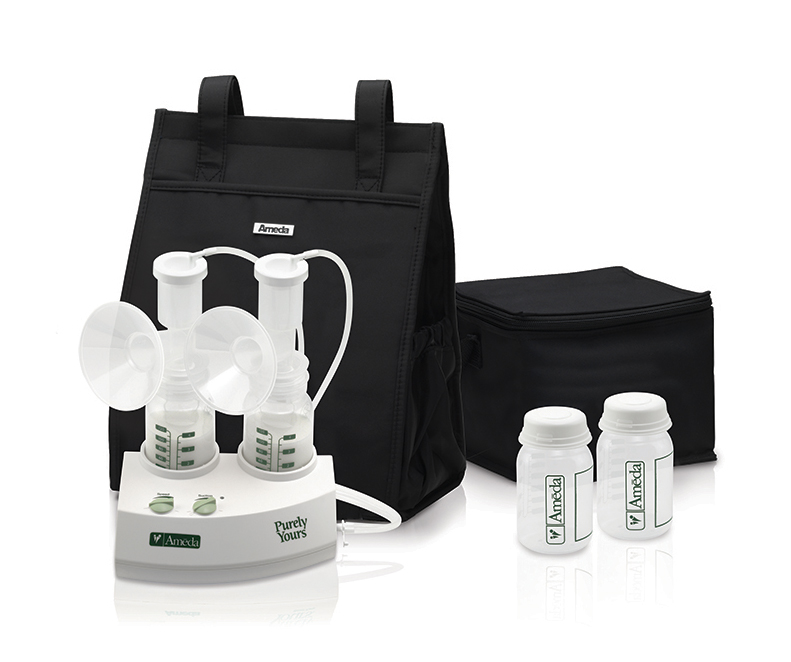
6 Breast Pumps Reviewed: Pros and Cons
I have tried a lot of pumps
I guess you could say I’m obsessed. Not with pumping, but with finding the right pump. And, let me tell you, I have searched high and low. I don’t even want to think about how much I have spent on breast pumps. But it’s worth it, right? Gotta feed the baby.
Pumps are a bit cheaper today under the Affordable Care Act which requires health insurance plans to cover breastfeeding support and supplies. This includes breast pumps and lactation consulting. As far as the pump is concerned, you don’t get the fancy bag with a million accessories through your insurance, but you do get the pump and the collection kit – enough to get started. If you want certain accessories, you can go get them yourself, and you will end up spending far less than if you bought the whole kit. Make sure to call your insurance company to find the details about this coverage.
There is no such thing as a perfect pump
My personal struggle pumping spurred my quest to find the ‘perfect’ breast pump. What I have discovered is that there is no such thing as a perfect pump; they all have pros and cons. And, in the big picture, they’re all about the same. Seriously. There are definite differences between the pumps that you have to think about for yourself and your lifestyle, but they all have the same basic function. I wish I could tell you that I pumped way more milk with one pump over another, but I can’t. It all works out to just about the same, as long as the pump is in good working order. Let me tell you a little about the pumps I have tried myself. This is based on my own personal experience, which could be different than your experience. Every body is different, just like every baby is different. You need to decide for yourself which pump you think will be the best for you.
1. Ameda Purely Yours
I used the Ameda almost exclusively for Baby Number One. I tried several other pumps at that time and kept coming back to the Ameda. For Baby Number Two, I tried using my original Ameda and got far less milk than my other new pumps. However, this is an unfair comparison because pumps degrade over time. It is advised that you get a new pump with each baby since any given pump will degrade (so take advantage of your insurance benefits). I want you to know about my experience with Ameda with Baby Number Two so you will understand that old pumps are not as good as new pumps. The Ameda worked great for the first baby, but it was past it’s prime for the second.

Copyrighted materials owned by Ameda, Inc. and used with permission
Pros:
- Closed System, so no concerns about hygiene or mold
- Built-in cups to set bottles after pumping (less chance of spilling precious milk)
- Parts available at Target and Babies R Us
- GREAT customer service (they sent me a new pump when my motor failed with Baby Number One)
- Car charger available
- Able to operate on batteries
- Adjustable speed and suction, so you can customize pumping to what works best for you
Cons:
- The built-in cups make it a bit bulky
- Narrow neck bottles, which are harder to hand wash without a bottle brush
- No pre-set let-down feature, but you can create this by increasing the speed of the suction pattern
2. Hygeia Enjoye
This is a good pump, but I liked it less than the Ameda when pumping for Baby Number One. I honestly haven’t tried it again for Baby Number Two. The main reason I didn’t like it is that it is LARGE, as in hospital-grade-pump large. I work — and have to pump at work — so it felt like a lot to lug back and forth at the time.
Pros:
- Closed system, so no concerns about hygiene or mold
- Wide mouth bottles, which are easy to wash by hand without a bottle brush
- Adjustable speed and suction, so you can customize pumping to what works best for you
Cons:
- LARGE
- I don’t believe the insurance pump comes with an internal battery, which is challenging if you need to pump without a power supply
- In stores, but not big-box stores. If not sold in your area, you will have to buy accessories and parts online
- No pre-set let-down feature, but you can create this by increasing the speed of the suction pattern
3. Dr. Brown’s Simplisse
I bought this pump because they had a generous return policy at the time (not sure if this is still the case). I loved the concept of the pump – it utilizes breast compression along with suction, so it is more like how a baby nurses. However, concept did not translate well into function. I had problem after problem with this pump. Their customer service was terrific and helped troubleshoot every step of the way. After a Skype call with one of their lactation consultants, they finally let me return it for a refund. I can honestly say that this is the only pump I used where I pumped noticeably less milk. My supply actually dropped, and I had to work hard to get it back.
Pros:
- Closed system, so no concerns about hygiene or mold
- Adjustable speed and suction, so you can customize pumping to what works best for you
Cons:
- LARGE
- Narrow neck bottles, which are harder to hand wash without a bottle brush
- Collection kit is HEAVY, so it is hard to keep in place, even with a hands-free bra
- Breast shield does not easily fit through the hole of most hands-free bras
- Weak suction and the breast compression feature does not make up for the weak suction
- No pre-set let-down feature, but you can create this by increasing the speed of the suction pattern
4. Rumble Tuff Serene Express
This pump is a newcomer to the market. It is gaining popularity, and I understand why. The Rumble Tuff was my primary pump for Baby Number Two. It is the smallest pump I own and also the strongest. You have to be careful when you set the suction strength, because it has some major power behind it that can catch you off-guard. This pump is cute, easy to tote around, and is very effective. It is the only insurance pump to come with a bag – a reusable grocery-type bag, but it serves my purposes just fine. It is also the only pump I own with a timer. That doesn’t sound like it would be a major feature, but it is so nice to know exactly how long you have been pumping. I lose track of time with my other pumps and can’t track if it is taking me longer than usual to get milk (this could be an indicator that you are having a problem with a part on the pump).
The two major challenges with this pump are easily overcome in my opinion, but they are still challenges. The biggest one is that the parts are available online only. To prevent getting stuck with a pump that is not operating perfectly while you wait for your order to ship, I would recommend pre-ordering several valves and a set of tubing. Those are the parts that need replacing the most, so it is best to always have them on hand (this goes for all pumps). The second challenge is that it does not come with a car adapter. I tried the Medela 12 volt car adapter and it worked for awhile, but then gave me an error message. My next solution worked – I bought a cheap vehicle power inverter and can plug the AC adapter into the power inverter. The suction is just as strong as if it was plugged into the wall.
Pros:
- Closed system, so no concerns about hygiene or mold
- Wide mouth bottles, which are easy to wash by hand without a bottle brush
- Let-down (2-phase) feature – the speed begins at a fast rate to promote let-down and then you push a button to move to a slower speed once you have milk. This mimics the same pattern as your baby.
- Digital display with timer
- Free adapter to make the pump into a manual pump (useful feature if you find yourself in a power outage)
Cons:
- Replacement parts unavailable in stores – online only
- No vehicle adapter available, but can try Medela 12-volt adapter or power inverter
- All pumps are loud, but this one seems to be a tad louder (probably because it has such strong suction!)
5. Lucina Care Melodi Prime
Ugh, this pump is terrible. I got this as an insurance pump for Baby Number Two. I was excited about it, because it was a brand new pump on the market, and it is designed to mimic baby’s suction pattern more closely than even the Medela and Rumble Tuff automatic programs. It is also supposed to have the same suction level as a hospital-grade pump. A hospital-grade pump with a better program for extracting milk? Sign me up!
Unfortunately, the Melodi Prime never lived up to all of the marketing hype. In full disclosure, I participated in the Beta testing of the pump – they still billed my insurance for it, but it was before the full market launch of the product. Perhaps they have worked out some of the kinks, although some of my complaints are inherent to their design.
One of my biggest issues was with a pause that is built into the pumping program. The marketing information will tell you that the pause is designed to allow milk to let down as it does when the baby takes a breath. What I can tell you is that it was an extremely annoying feature. From a sensorial perspective, I was able to drown out the pumping sensation with other pumps because it was a consistent motion, spaced with a consistent break between pumps. Because it was pumping the exact same way over and over, I could forget about it and not focus on it. The pause that is designed in the Melodi Prime program made it so I was perpetually focused on the pumping. Right when it would get in a rhythm, it would stop and make a loud whirring noise and then stop before eventually starting up again. It was very disruptive and I could not take my attention away from the pumping. This is not ideal because, let’s face it, pumping is not the best sensation in the world. I much prefer a situation where I can focus on something else rather than on the pumping. I also found that this pause made the pumping take a lot longer to get the milk out. This is counter to what the marketing says – Lucina Care claims that Moms make 20-25% more milk because of this pause.
Pros:
- Closed system, so no concerns about hygiene or mold
- Pump is small and lightweight, so it is more portable than others
- Comes with a tote bag
- Able to operate on 4 AA batteries
Cons:
- Replacement parts unavailable in stores – online only
- Narrow neck bottles, which are harder to hand wash without a bottle brush
- Pause feature annoying and resulted in a longer pumping session (for me)
6. Medela Pump-in-Style Advanced
Medela seems to be the brand that everyone knows. Everyone assumes it is the best because it is the best marketed. From my perspective, it is a good pump, but it is not without its challenges. One of the biggest challenges is that it is an Open System. This means that the air that is used to create the suction travels through the actual motor. Closed Systems have a membrane that prevent this – all air is contained within the collection kit, the parts that you wash each time you pump.
The major disadvantage with an Open System is that condensation can build up in the tubing and in the motor itself and can cause molding. There are horror stories online of people opening up their Medela pump and finding it full of mold. The moldy air would pass over the breast milk, putting mold spores into your baby’s milk. GROSS!
Medela has created a protocol to address these challenges, but it does involve extra steps that many people do not take. To combat the condensation issue, you have to keep running your pump for several minutes after you disconnect the collection kits. This is easy – I just run it while I transfer my pumped milk to storage bags and wash the collection kit (honestly, I think this is a good practice to do for closed systems as it will make your tubing last longer). To combat the sanitization issue just in case there are mold spores present, Medela recommends you boil or steam sterilize your collection kit every day. You read that right — EVERY SINGLE DAY. Seriously, who does that? I polled my own friends. and at most, they will sterilize every other day. Medela has made it super easy with the steam sterilizing bags, which is so much faster than boiling water, but it is an extra expense (approximately $6 for five 20-use bags or 100 uses), and it is one more thing to remember and actually do. Is all of it do-able? Absolutely. But know about this before you get a Medela. And please make sure to not share the Medela with your friends or family after you are done pumping – open systems are not to be shared. This would be the equivalent of your friend putting her used toothbrush in your newborn’s mouth.
Pros:
- Let-down (2-phase) feature – starts at a faster rate and switches to a slower rate after a couple of minutes. This mimics the same pattern as your baby.
- Parts and accessories available at Target and Babies R Us
- Great customer service
Cons:
- OPEN System – Hygiene issues
- Must sterilize parts every day
- Must run pump to remove condensation from tubing after each pumping session
- Narrow neck bottles, which are harder to hand wash without a bottle brush
So there you go – my experience in a nutshell. How ridiculous is it that I have tried that many pumps? Hopefully my experiences will be helpful to you as you determine the best pump for you.
Once you start pumping, don’t get discouraged. It is not easy and doesn’t come naturally, but stick with it. You might feel like all your friends are super-producing cows, but one fact that helps me is that most moms who are full-time nursing will only be able to pump 1/2-2 ounces per pumping session (not per breast). Moms who can pump 4-8 ounces even when nursing full-time, have oversupply or their body responds well to the pump. Your odds of getting the most milk when only pumping once a day is to pump in the morning and try to time it at least an hour after baby has stopped nursing. Don’t get discouraged if it takes 2-3 pumping sessions to be able to have enough milk for one feeding – this is very normal. Your pumping output is NOT an indicator of your milk supply level. Some moms have plenty of milk when they are with their baby, but can’t pump enough when they are away from their baby. This indicates that your body just doesn’t respond well to the pump. Check KellyMom.com for their resources on what to try if you are not pumping enough. La Leche League also has some great resources on how to increase your pumping output and how to increase your milk supply.
Laura is Mom to two spirited daughters, neither of whom were perfect at breastfeeding, so her knowledge about breast pumps came out of necessity to find a way to provide breast milk to her girls. When pregnant with her second daughter, Laura realized that there were no local Austin companies that were able to provide breast pumps through insurance. Laura worked with Medical Express, PSI to develop a breast pump program so area moms would have a local option to receive their breast pump. Medical Express, PSI has several breast pump options available, can bill most insurance contracts, and has two Austin locations.
To learn more about Medical Express, PSI and how they can help you find a breast pump through your insurance, check out:

Medical Express PSI
www.medexpsi.com/products/breastpumps
512-445-0600
North
8800B Shoal Creek Blvd.
Austin, TX 78757
Facebook: @Medical-Express-PSI-North-Austin-882445648466365/
South
1701 W. Ben White Blvd. Ste. 162
Austin, TX 78704
Facebook: @Medical-Express-PSI-South-Austin-381819365315962/
Austin Expecting is Austin’s most exhaustive prenatal, birth and postpartum resource directory. Find all your pregnancy care and service providers in our comprehensive directory. Stay up to date with all the goings on for expectant moms with our events calendar. Connect with Austin moms and providers by following our blog. The advice and opinions on this website are for informational purposes only. Do not use this information against the advice of your medical practitioner. Always consult your doctor or practitioner for any health-related issues you may be experiencing.




